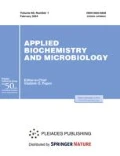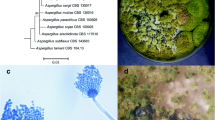Abstract
Four cultures of fungi of the genus Penicillium belonging to Furcatum Pitt subgenus, such as P. citrinum Thom, 1910; P. corylophilum Dierckx, 1901; P. fellutanum Biourge, 1923; and P. waksmanii Zaleski, 1927, produced the ergot alkaloids, namely, agroclavine-I, and epoxyagroclavine-I; their N-N-dimers, such as dimer of epoxyagroclavine-I and the mixed dimer of epoxyagroclavine-I and agroclavine-I; and also quinoline metabolites, namely, quinocitrinin A and quinocitrinin B. Physiological and biochemical characteristics of the producers were studied. Optimal conditions for the biosynthesis of metabolome components were determined. Zinc additive to the medium stimulated the biosynthesis of the ergot alkaloids in all cases; quinocitrinines production was increased only in P. citrinum, and that was suppressed in P. corylophinum, P. fellutanum, and P. waksmanii. This testifies that genes of the biosynthesis pathways are located in the different clusters of the producers.
Similar content being viewed by others
References
Tudzynski, P., Correia, T., Keller, U., Appl. Microbiol. Biotechnol., 2001, vol. 57, nos. 5–6, pp. 593–605.
Kozlovsky, A.G., in Medicinal and Aromatic Plant—Industrial Profiles. Ergot, the Genus Claviceps, Kren, V. and Cvak, L., Eds., Chur: Harwood Acad., 1999, pp. 479–499.
Kozlovsky, A.G., Solov’eva, T.F., Sakharovskii, I.G., and Adanin, V.M., Prikl. Biokhim. Mikrobiol., 1982, vol. 18, no. 4, pp. 535–541.
Kozlovsky, A.G., Vepritskaya, I.G., and Gayazova, N.I., Prikl. Biokhim. Mikrobiol., 1986, vol. 12, no. 2, pp. 205–209.
Kozlovsky, A.G., Zhelifonova, V.P., Adanin, V.M., Antipova, T.V., Ozerskaya, S.M., Kochkina, G.A., and Grefe, U., Mikrobiologiya, 2003, vol. 72, no. 6, pp. 816–821.
Antipova, T.V., Zhelifonova, V.P., and Baskunov, B.P., Ozerskaya, S.M., Ivanushkina, N.E., Kozlovsky, A.G., Prikl. Biokhim. Mikrobiol., 2011, vol. 47, no. 3 (in press).
Zelenkova, N.F., Vepritskaya, I.G., Adanin, V.M., Sakharovskii, V.G., Nefedova, M.Yu., and Kozlovsky, A.G., Dokl. Akad. Nauk SSSR, 1990, vol. 313, no. 6, pp. 1494–1496.
Kozlovsky, A.G., Zelenkova, N.F., Adanin, V.M., Sakharovskii, V.G., and Arinbasarov, M.U., Prikl. Biokhim. Mikrobiol., 1995, vol. 31, no. 5, pp. 540–544.
Kozlovsky, A.G., Zhelifonova, V.P., Antipova, T.V., Adanin, V.M., Ozerskaya, S.M., Kochkina, G.A., Schlegel, B., Dajhse, H.M., Gollmick, F.A., and Grafe, U., J. Antibiot., 2003, vol. 56, no. 5, pp. 488–491.
Kozlovsky, A.G., Zhelifonova, V.P., and Antipova, T.V., Prikl. Biokhim. Mikrobiol., 2005, vol. 41, no. 5, pp. 568–572 [Appl. Biochem. Microbiol. (Engl. Transl.), 2005, vol. 41, no. 5, pp. 499–502].
Kozlovsky, A.G., Zhelifonova, V.P., Antipova, T.V., and Zelenkova, N.F., Prikl. Biokhim. Mikrobiol., 2010, vol. 46, no. 5, pp. 572–576 [Appl. Biochem. Microbiol. (Engl. Transl.), 2010, vol. 46, no. 5, pp. 525–529].
Lovkova, M.Ya., Buzuk, G.N., and Ponomareva, S.M., Prikl. Biokhim. Mikrobiol., 1995, vol. 31, no. 1, pp. 80–86.
Kozlovsky, A.G., Zhelifonova, V.P., Antipova, T.V., and Lysanskaya, V.Ya., Mikrobiologiya, 2006, vol. 75, no. 3, pp. 334–341.
Brakhage, A.A., Broun, P., and Turner, G., Mol. Gen. Genet., 1994, vol. 242, no. 1, pp. 57–64.
Lorenz, N., Wilson, E.V., Machado, G., Shardl, C.L., and Tudzynski, P., Appl. Environ. Microbiol., 2007, vol. 73, no. 22, pp. 7185–7191.
Young, C., McMillan, L., Telfer, E., and Scott, B., Mol. Microbiol., 2001, vol. 39, no. 3, pp. 754–764.
Author information
Authors and Affiliations
Corresponding author
Additional information
Original Russian Text © A.G. Kozlovsky, V.P. Zhelifonova, T.V. Antipova, N.F. Zelenkova, 2011, published in Prikladnaya Biokhimiya i Mikrobiologiya, 2011, Vol. 47, No. 4, pp. 469–473.
Rights and permissions
About this article
Cite this article
Kozlovsky, A.G., Zhelifonova, V.P., Antipova, T.V. et al. Physiological and biochemical characteristics of the genus Penicillium fungi as producers of ergot alkaloids and quinocitrinins. Appl Biochem Microbiol 47, 426–430 (2011). https://doi.org/10.1134/S0003683811040065
Received:
Published:
Issue Date:
DOI: https://doi.org/10.1134/S0003683811040065



